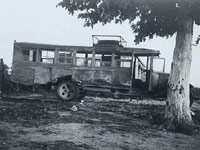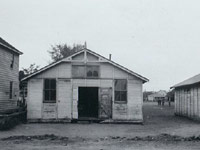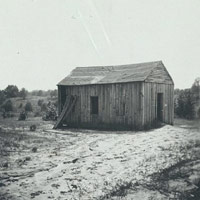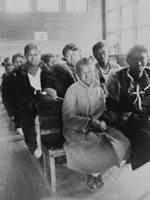
After the abolition of slavery in the United States, three Constitutional
amendments were passed to grant newly freed African Americans legal
status: the Thirteenth Amendment abolished slavery, the Fourteenth
provided citizenship, and the Fifteenth guaranteed the right to
vote. In spite of these amendments and civil rights acts to enforce
the amendments, between 1873 and 1883 the Supreme Court handed
down a series of decisions that virtually nullified the work of
Congress during Reconstruction. Regarded by many as second-class
citizens, blacks were separated from whites by law and by private
action in transportation, public accommodations, recreational facilities,
prisons, armed forces, and schools in both Northern and Southern
states. In 1896 the Supreme Court sanctioned legal separation of
the races by its ruling in H.A. Plessy v. J.H. Ferguson,
which held that separate but equal facilities did not violate the
U.S. Constitution's Fourteenth Amendment.
Beginning in 1909, a small group of activists organized and founded
the National Association for the Advancement of Colored People
(NAACP). They waged a long struggle to eliminate racial discrimination
and segregation from American life. By the middle of the twentieth
century their focus was on legal challenges to public-school segregation.
Two major victories before the Supreme Court in 1950 led the NAACP
toward a direct assault on Plessy and the so-called "separate-but-equal" doctrine.

|

|
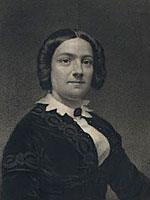
Margaret Crittenden Douglass.
Educational Laws of Virginia; The Personal Narrative of Mrs. Margaret Douglass,
a Southern Woman, Who Was Imprisoned for One Month in the Common Jail of Norfolk,
under the Laws of Virginia, for the Crime of Teaching Free Colored Children
to Read.
Page 2
Boston: John P. Jewett and Co., 1854.
General Collections (1)
|
Imprisoned for Teaching Free Blacks
The prohibition of education for African
Americans had deep roots in American history. According to
the 1847 Virginia Criminal Code: "Any white person who shall
assemble with slaves, [or] free negroes . . . for the purpose
of instructing them to read or write, . . .shall be punished
by confinement in the jail . . . and by fine . . ." Under
this code, Margaret Douglass, of Norfolk, Virginia, a former
slaveholder, was arrested, imprisoned, and fined when authorities
discovered that she was teaching "free colored children" of
the Christ's Church Sunday school to read and write. In her
defense, Mrs. Douglass noted that she was not an abolitionist,
and did not engage in undermining the institutions of the
South. |
Upholding School Segregation: The Roberts Case
Five-year-old Sara Roberts was forced
to walk past several white schools to reach the "colored" primary
school. Her father, Benjamin Roberts, a black printer, filed
a lawsuit against the city of Boston to integrate public
schools. In 1849 reformer and future U.S. Senator Charles
Sumner represented Roberts and challenged school segregation
in the Boston court. Separate schools for African Americans,
he argued, in effect branded "a whole race with the stigma
of inferiority and degradation." The Massachusetts Supreme
Court, however, upheld segregation in a widely cited ruling.
Influential Chief Justice Lemuel Shaw noted that Boston's
separate schools possessed substantially equal facilities
and declared that school integration would only increase
racial prejudice. |
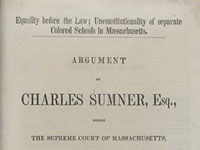
Charles Sumner.
Equality Before the Law: Unconstitutionality of Separate Colored Schools in
Massachusetts.
Washington: F. & J. Rives & Geo. A. Bailey, 1870.
Rare Book and Special Collections
Division (1F)
|
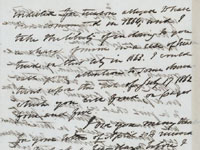
Stephen Field to Salmon
Chase,
June 30, 1866.
Page 2
Holograph letter.
Manuscript Division (2C)
|
The Fourteenth Amendment
The Fourteenth Amendment to the Constitution,
which allowed the Federal Government to protect the civil
rights of individuals, including African Americans, against
state encroachment, was ratified in 1868. The amendment also
defined national citizenship and extended it to former slaves
freed by the Civil War. This 1866 letter to Supreme Court
Chief Justice Salmon P. Chase is from Associate Justice Stephen
J. Field, whose judicial opinions would significantly influence
subsequent interpretations of the amendment. Field termed
the amendment, which had recently been passed by Congress
and sent to the states for ratification, "just what we need" and
said it showed that "the American people do not intend to
give up all that they have gained by the war."

|
Plessy v. Ferguson, 1896
By the time Homer A. Plessy, an octoroon
(one-eighth Negro blood), who lived in New Orleans, challenged
that city's right to segregate public transportation by riding
in a Whites Only rail car, the constitutional amendments,
passed after the Civil War and written to provide protections
and rights for Negro citizens, had been eroded. The Louisiana
state courts ruled against Plessy, and his subsequent appeal
to the U. S. Supreme Court was denied in 1896. The impact
of Plessy was to relegate blacks to second-class
citizenship. They were separated from whites by law and by
private action in transportation, public accommodations,
recreational facilities, churches, cemeteries and school
in both Northern and Southern states.

|
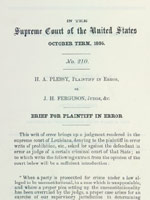
Phillip B. Kurland.
Landmark Briefs and Arguments
of the Supreme Court of the United States: Constitutional Law. Volume
13.
Arlington, Virginia: University Publications
of America, Inc., 1975.
Law Library (3)
Available from LexisNexis®,
a division of Reed Elsevier Inc.
|
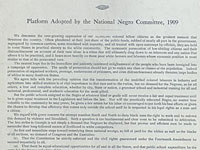
Platform adopted by the National
Negro Committee, 1909.
NAACP Records,
Manuscript Division (8)
Courtesy of the NAACP
|
The National Negro Committee, 1909
In 1908 socialist William English Walling
published an exposé about a bloody race riot in Springfield,
Illinois. As a result, in January 1909, an interracial group
assembled in his apartment to discuss proposals for an organization
that would advocate the civil and political rights of African
Americans. The group decided to issue a "call" for a national
conference on the centennial of Abraham Lincoln's birth,
February 12, 1909. As a result of the "call," the National
Negro Conference was held in New York on May 31 and June
1, 1909. At the second annual meeting, May 12, 1910, the
Committee adopted the formal name of the organization--the
National Association for the Advancement of Colored People
(NAACP). Among the "first and immediate steps" listed at
the bottom of this founding document is "That there be equal
educational opportunities for all and in all the States,
and that public school expenditure be the same for Negro
and white child." |
The Pink Franklin Case
The NAACP undertook its first major legal
case in 1910 by defending Pink Franklin, a black South Carolina
sharecropper accused of murder. When Franklin left his employer
after receiving an advance on his wages, a warrant was sworn
for his arrest under an invalid state law. Armed policemen
arrived at Franklin's cabin before dawn to serve the warrant
without stating their purpose and a gun battle ensued, killing
one officer. Franklin was convicted of the murder and sentenced
to death. The NAACP interceded, and Franklin's sentence was
commuted to life imprisonment. Eventually, he was set free
in 1919. In this letter to Mary White Ovington, Albert Pillsbury,
an attorney and NAACP supporter, recommends the appeal to
South Carolina Governor Martin F. Ansel. |
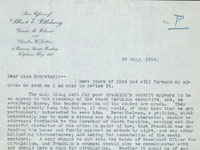
Albert Pillsbury to NAACP
Secretary Mary White Ovington,
July 26, 1910.
Typed letter.
NAACP Records,
Manuscript Division (9)
Courtesy of the NAACP
|
![In the Supreme Court of the United States, October Term, 1916 [no.231] Charles H. Buchanan v. William Warley](images/br0014s-th.jpg)
In the Supreme Court of
the United States, October Term, 1916 [no.231] Charles
H. Buchanan
v. William Warley. Pamphlet.
NAACP Records,
Manuscript Division (14)
Courtesy of the NAACP
|
Buchanan v. Warley
The NAACP sought out cases that infringed
on the Fourteenth and Fifteenth Amendments in order to set
legal precedents and ultimately secure the constitutional rights
of African Americans. An early victory was Buchanan v.
Warley, a case involving residential segregation in Louisville,
Kentucky. Moorfield Storey, the NAACP's first president and
a constitutional attorney, argued the case before the U.S.
Supreme Court in April 1917. The Court reversed the decision
of the Kentucky Court of Appeals, ruling that the Louisville
ordinance violated the Fourteenth Amendment. As a result of
the ruling, whites resorted to private restrictive covenants,
in which property owners agreed to sell or rent to whites only.
The Supreme Court declared this practice unconstitutional in Shelley
v. Kraemer (1948). Buchanan v. Warley was cited
in the Brown decision to challenge the legality of
segregated public schools.

|
Chief Strategist Charles H. Houston
Charles Hamilton Houston was the chief
strategist of the NAACP's legal campaign that culminated
in the Brown decision. Born in Washington, D.C.,
he graduated from Amherst College, in 1915. In 1923 he became
the first African American to earn a Doctor of Juridical
Science degree at Harvard, where he studied under Felix Frankfurter.
Houston intermittently practiced law as a partner in Houston & Houston,
the prestigious firm his father founded in 1892. In 1924
he joined the faculty of Howard University Law School, and
was appointed Vice Dean in 1929. By 1932 he had transformed
the law school from a part-time evening school to a fully
accredited institution that trained a cadre of civil rights
attorneys. In 1935 the NAACP hired Houston as its first full-time
salaried Special Counsel and created the Legal Department
under his supervision. Although he returned to private practice
in
1938, Houston continued to advise the NAACP until his death
on April 22,1950. |
The Library of Congress
does not have permission to show this image online.
Charles H. Houston (1895-1950), ca. 1940.
Gelatin silver print.
Prints and Photographs Division (26E) |
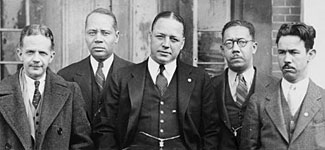
Walter White, NAACP Executive
Secretary, with attorneys Charles Houston, James G. Tyson,
Leon A. Ransom, and Edward P. Lovett, 1933.
Gelatin silver print.
Visual Materials from the NAACP Records,
Prints and Photographs Division (22)
Courtesy of the NAACP
|
The NAACP Legal Team, 1933
Charles Houston was the Vice Dean of
the Howard University law School before becoming NAACP special
counsel in 1935. Leon Ransom was a professor at the Howard
Law School. Edward Lovett and James Tyson were graduates.
Lovett also worked for the firm of Houston & Houston
in Washington, D.C. The entire team collaborated to plan
and litigate desegregation cases. Pictured in this image
are NAACP attorneys, with the exception of Walter White,
who is the executive secretary of the NAACP, from 1931-1955. |
Prominent NAACP Lawyer William Hastie
William Henry Hastie (1904-1976), civil
rights attorney, public official, and federal judge, was
born in Knoxville, Tennessee, on November 17, 1904. Hastie
followed in his cousin Charles Houston's footsteps by attending
Amherst College and Harvard Law School, where he studied
with Felix Frankfurter, receiving a Bachelor of Law in 1930
and a Doctor of Juridical Science in 1933. Between degrees,
Hastie joined Houston & Houston and the faculty of Howard
University Law School, becoming Dean in 1939. During the
1930's he began his tenure with the NAACP as a strategic
advisor and counsel. He also
served as Chairman of the Legal Committee from 1939-1949
and on
the Board of Directors of the NAACP Legal Defense Fund from
1941-1968. In 1949, Hastie was appointed to the U.S. Court
of Appeals for the Third Circuit. In 1954 and 1967, he was
considered for the Supreme Court. |
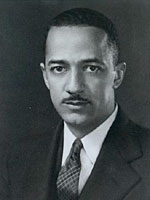
William Hastie, Chairman
of the National Legal Committee, NAACP, n.d.
Gelatin silver print.
Visual Materials from the NAACP Records,
Prints and Photographs Division (22B)
Courtesy of the NAACP
|
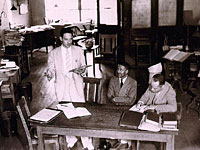
Thurgood Marshall and Charles
Houston with their client Donald Gaines Murray during court
proceedings, ca. 1935.
Gelatin silver print.
Visual Materials from the NAACP Records,
Prints and Photographs Division (28)
Courtesy of the NAACP
|
Murray v. Maryland, 1936
While practicing law in Baltimore, Thurgood
Marshall worked diligently to amass black teachers' salary
cases for the NAACP. He also urged Houston to take on Murray
v. Maryland, a stronger prospect than the Hocutt case.
The plaintiff, Donald G. Murray was a highly
qualified Amherst graduate who had been denied entry to the
University of Maryland Law School. In 1935 Houston consented
and argued the case with Marshall in Baltimore City Court
before Judge Eugene O'Dunne. The Judge ruled that Murray
had been rejected solely on the basis of race and ordered
the University to admit him. Murray became the first black
graduate of the University's law school in 1938. |
The Garland Fund and Margold Report
In 1922 Charles Garland, a student at
Harvard College, donated $800,000 to establish The American
Fund for Public Service, a foundation dedicated to radical
social reform. The fund, generally known as the Garland Fund,
awarded a $100,000 grant to the NAACP in for the employment
of a special counsel to study the legal status of African
Americans and plan a legal campaign. The NAACP hired Nathan
Margold, a former assistant U.S. attorney for the Southern
District of New York, on the endorsement of Felix Frankfurter
and Charles H. Houston. Margold focused his report on an
assessment of discrimination in public schools. He advised
the NAACP to"boldly challenge the constitutional validity"of
underfunded black schools as a violation of the equal protection
clause of the Fourteenth Amendment. |
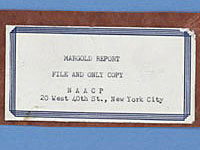
Nathan R. Margold.
Preliminary Report
to the Joint Committee Supervising the Expenditure of the 1930 Appropriation
by
the American Fund for Public Service, [1931].
Page 2
NAACP Records,
Manuscript Division (21)
Courtesy of the NAACP
|
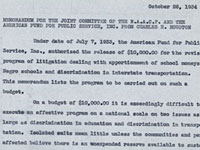
Memorandum for the Joint
Committee of the NAACP
and the American Fund for Public
Service, Inc.
from Charles H. Houston,
October 26, 1934.
NAACP Records,
Manuscript Division (25)
Courtesy of the NAACP
|
Campaign Against Discrimination in Education
Nathan Margold resigned from the NAACP in 1933 to join the
Interior Department as a solicitor. In 1934, the Joint Committee
of the NAACP and the American Fund for Public Service retained
Charles H. Houston on a part-time basis to direct a legal
campaign against
discrimination in education and interstate transportation.
Houston reviewed the Margold Report, then
composed this memorandum, in which he advocated using the
scant $10,000 funds available to fight "the more acute issue
of discrimination in education." Houston diverged from Margold
by delaying a direct strike on public schools, instead attacking
state graduate and professional schools. His devised systematic
assault would "us[e] the court as a laboratory" to develop
a succession of test cases and gradually chip away at the "separate
but equal" doctrine. |
Progress of the Hocutt v. Wilson case, 1933
In 1933 the NAACP undertook Hocutt
v. Wilson, the first test case involving segregation
in higher education. The plaintiff was Thomas R. Hocutt,
a student at the North Carolina College for Negroes, who
had been denied admission to the University of North Carolina's
School of Pharmacy. Attorneys Conrad O. Pearson and Cecil
McCoy appealed to the NAACP for assistance after filing
a law suit. Charles Houston recommended William Hastie
to direct the litigation. According to Pearson, "the white
Bar [in attendance] was unanimous in its praise," of Hastie's
and his colleagues' trial performance, but the case was
undermined by the North Carolina College President's refusal
to release Hocutt's transcript. |
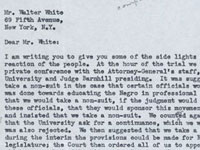
Conrad O. Pearson to NAACP
Executive Secretary Walter White reporting on the progress
of the Hocutt v. Wilson case, March 31, 1933.
Typed letter.
NAACP Records,
Manuscript Division (22A)
Courtesy of the NAACP
|
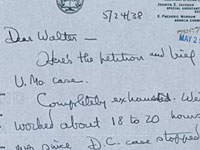
Charles H. Houston to Walter
White reporting on the progress of Missouri ex rel.
Gaines v. Canada,
May 24, 1938.
Autograph letter.
NAACP Records,
Manuscript Division (33)
Courtesy of the NAACP
|
Integrating University of Missouri Law School
Charles Houston, NAACP Special Counsel,
targeted law schools. He was optimistic that based on their
own experience, white judges would reject the unequal training
for black attorneys. After winning the Murray case,
Houston worked with Marshall and Sidney Redmond on Missouri
ex rel. Gaines v. Canada. In 1935 the University of
Missouri Law School denied entry to Lloyd Gaines, an honor
graduate of Lincoln University (Mo.), offering to build a
law school at Lincoln or pay Gaines's tuition at an out-of-state
school.
Houston and Redmond argued the case before the U.S. Supreme
court in 1938. The Court ruled that Missouri must offer Gaines
an equal facility within its borders or admit him to the
University's law school. In response, the State legislature
tried to erect a makeshift law school inciting Houston to
renew litigation. Meanwhile, Gaines disappeared, abruptly
ending the case. His fate remains a mystery. |
NAACP Leaders Joel and Arthur Spingarn
The favorable publicity generated by
the Pink Franklin case attracted new supporters to the NAACP.
Among them were Joel E. Spingarn, chairman of Comparative
Literature at Columbia University, and his brother, Arthur,
a lawyer, shown in this photograph. In January 1911, the
NAACP organized its first branch in Harlem, New York with
Joel's help. The branch established a vigilance committee,
which became the National Legal Committee, to deal "with
injustice in the courts as it affects the Negro." Arthur
worked pro bono because the NAACP could not afford
to hire attorneys on a regular basis and was often able to
convince other prominent attorneys to volunteer their services.
Arthur served as the chairman of the National Legal Committee
until 1939. The members of the Committee also included Felix
Frankfurter and Charles Houston. |
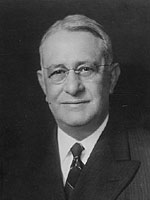
Arthur Spingarn.
Gelatin silver print.
Visual Materials from the NAACP Records,
Prints and Photographs Division (11A)
Courtesy of the NAACP
|
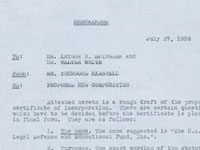
Thurgood Marshall to Arthur
B. Spingarn and Walter White concerning the founding of
the NAACP Legal Defense and Educational Fund, July
27, 1939.
Memorandum.
NAACP Records,
Manuscript Division (36)
Courtesy of the NAACP
|
Founding of the NAACP Legal Defense and Educational Fund
In 1939 the Treasury Department refused
to grant tax-exempt status to the NAACP because of a perceived
conflict between the Association's litigation and lobbying
activities. In response, the NAACP created its Legal Defense
and Educational Fund, Inc., as a non-profit separate arm
to litigate cases and raise money exclusively for the legal
program. It shared board members and office space with the
NAACP. Arthur Spingarn was president of both organizations.
Thurgood Marshall served concurrently as the Fund's director
and NAACP Special Counsel. He hired a new team of gifted
young lawyers to work for the Fund, including Robert L. Carter,
Jack Greenberg, Constance Baker Motley, and Franklin Williams.
The Legal Defense Fund severed ties with the NAACP in 1957
but retained its original name. |
George W. McLaurin Segregated to the Anteroom
George W. McLaurin, a veteran school teacher living in
Oklahoma applied to the all-white University of Oklahoma
to pursue an advance degree in education in 1948. His application
was rejected because Oklahoma statutes made it illegal
for blacks and whites to attend the same school. McLaurin
filed a complaint against the University on the state court
level and won. He was allowed to attend classes but not
with his fellow students. This photograph shows how he
was segregated to the anteroom of a classroom in 1948 after
his admission. In 1950, McLaurin filed suit with the and
U.S. Supreme Court and won. The case paved the way for
the Brown v. Board of Education cases.
|
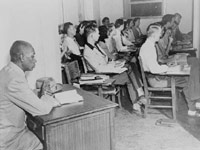
George W. McLaurin, 1948.
Gelatin silver print.
Visual Materials from the NAACP Records,
Prints and Photographs Division (47)
Digital ID# cph 3c16927
Courtesy of the NAACP
|
The Library of Congress
does not have permission to show this image online.
Robert Carter (right), Heman Sweatt
(center), and NAACP Administrator Roy Wilkins (left)
during a press conference interview at the NAACP's New York
City headquarters, ca. 1950.
Gelatin silver print.
New York World-Telegram & Sun Collection,
Prints and Photographs Division (43) |
Press Conference for the Sweatt Case
Thurgood Marshall hired Robert L. Carter
as a legal assistant at the Legal Defense Fund in 1944 and
promoted him to assistant counsel in 1945. Carter graduated
from Lincoln University (Pa.), Howard Law School, and earned
a Master of Laws from Columbia University. He helped to prepare
briefs in the McLaurin and Sweatt cases, and argued McLaurin
in Oklahoma and before the Supreme Court. Carter later became
Marshall's key aide on the Brown litigation.
He recommended the social science strategy that became a
crucial factor in the Brown decision. He also wrote
the brief for the Brown case and delivered the argument
before the Supreme Court. He served as the NAACP's General
Counsel from 1956 to 1968. In 1972 President Nixon appointed
Carter to the U.S. District Court for the Southern District
of New York, where he still presides as a judge. |
The Henderson, McLaurin and Sweatt Cases
The Legal Defense Fund waited twelve
years to pursue two precedent-setting cases before the Supreme
Court. In 1946 the University of Texas Law School denied
entry to Heman Sweatt and proposed a makeshift law school
for him in the basement of a building near all-black Prairie
View University. In 1948 George McLaurin, a teacher, applied
to the University of Oklahoma to pursue his doctorate. The
University admitted McLaurin but segregated him from white
students. The Court also considered another case, Henderson
v. United States, which involved segregated dining cars
on interstate trains. On June 5, the Court ruled in favor
of all three plaintiffs. In Sweatt and McLaurin,
the Court held that intangible factors could create educational
inequality. These factors included the Texas Law School's
superior reputation, faculty, and alumni network. The Court's
decisions in these cases weakened the structure of legalized
segregation. |
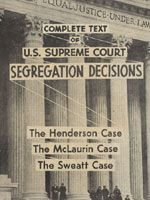
Complete Text of U. S. Supreme
Court Decisions: The Henderson Case, The McLaurin Case,
The Sweatt Case. Pittsburgh: The Pittsburgh
Courier, 1950.
Pamphlet.
NAACP Records,
Manuscript Division (46)
Courtesy of the NAACP
|
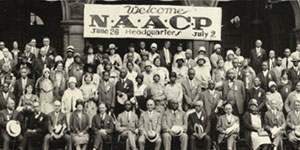
Twentieth Annual Session of
the NAACP in Cleveland, Ohio, June 26, 1929.
Gelatin silver print.
Visual Materials from the NAACP Records,
Prints and Photographs Division (19)
Courtesy of the NAACP
|
Twentieth Annual Session of the NAACP
In 1929, the annual conference of the
NAACP convened in Cleveland to mark the Association's twentieth
anniversary. The NAACP had much to celebrate. It had launched
a successful anti-lynching crusade; won important legal battles;
and organized 325 branches. The Crisis, the Association's
official organ, was the leading black periodical with a circulation
of more than 100,000. Among the NAACP officials seated in
the front row (left to right) are W.E.B. Du Bois, editor
of The Crisis; James Weldon Johnson, NAACP Executive Secretary,
1920-1930; Robert Bagnall, Director of Branches; Daisy Lampkin,
Regional Field Secretary; Walter White, Assistant Secretary,
1918-1929; William Pickens, Field Secretary; and Arthur Spingarn,
Chairman of the Legal Committee.

|
An African American School House
This photograph shows the condition of
many African American schools in the first decades of the
twentieth century. Many states simply did not allocate enough
funds to provide "equal" schools in the separate black schools.
In South Carolina, the resulting inadequate condition for
black children led to the Briggs v. Elliot case
in 1954. The Briggs case would become one of the
five included in the Brown decision. |
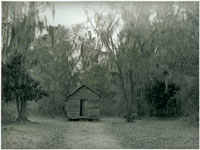
Marion Post Wolcott.
African American School House near Summerville,
South Carolina, 1938
Gelatin silver print.
FSA-OWI Photograph Collection,
Prints and Photographs Division (26)
[digital ID# br0026a]
|
|

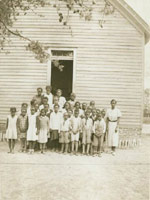






![In the Supreme Court of the United States, October Term, 1916 [no.231] Charles H. Buchanan v. William Warley](images/br0014s-th.jpg)
